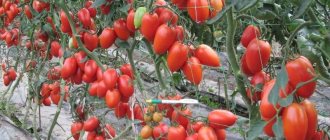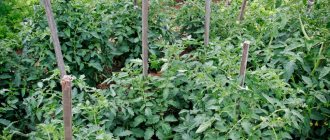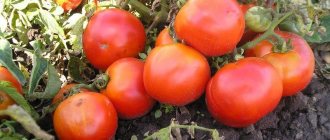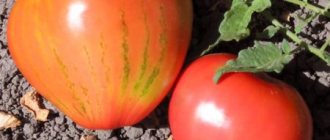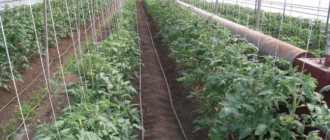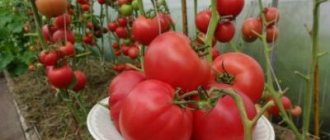Tomato Fatima is a pink, early-ripening variety of tomatoes. The variety was bred by Russian breeders more than 10 years ago. The tomato is popular among gardeners; it is successfully grown in agro-industrial complexes. It is loved by consumers for the delicate taste of its sugary and juicy pulp.
Agronomists and amateur gardeners pay tribute to its unpretentiousness, compactness and high yield. Already in the middle of summer you can collect large fruits of a rich pink color, and the bush will bear fruit all summer. Even novice gardeners can easily cope with caring for this variety and can even collect seeds for the next season.
Description
The Fatima variety belongs to the low-growing group, the maximum height is just over half a meter; the bushes do not grow higher.
Development occurs through the growth of lateral shoots; few stepsons are formed. If the summer is warm and there is no heat, then pinching should be done regularly. But in hot and especially dry weather, the stepsons are not removed. The foliage will protect the bush from hot rays. There is no need to pinch the top - the plant does not grow higher than normal. There are exceptions - the bush can, under favorable conditions, reach a meter in height.
In open ground, a tomato ripens for about 90 days . Indeed, it ripens quickly and manages to produce several harvests. The fruits ripen until the second half of September.
Fruit characteristics and yield
During the flowering period, a single flower is tied at the top; it is quite large in size. This flower will give the best ovary and the largest fruit. All other inflorescences are collected in brushes. The first flower tassel can be found above the 6th leaf.
Tomato fruits have a ribbed surface and are shaped like a heart. Sometimes you can find fused tomatoes, the lower part is sharper, the upper part is round and voluminous. The stalk has so-called shoulders - this is a dark green spot. The ripe fruit has a rich, dense pink color or the distinct color of ripe raspberries.
The pulp is juicy and has a sweetish taste. Many gardeners consider this variety to be a dessert variety . The weight of a large fruit can exceed 0.5 kg. The average weight is approximately 250 g; from one bush you can harvest more than 2 kg of beautiful, tasty tomatoes.
Photo
In the photo below you can see what this variety of tomatoes looks like:
Main characteristics of the bush
This is a representative of early varieties and performs well both in open ground conditions and in greenhouses. When describing a tomato, we can note the following:
- height of an adult plant is 40 - 60 cm;
- stems are strong and fleshy;
- spreading bush;
- does not require pinching;
- high yield - on average 2.5 kg per bush.
There are not many problems when growing this variety. The main thing is to tie the plant up in time, otherwise it will simply fall apart under the weight of the fruit.
Important! The Fatima tomato also has a hybrid of the same name “Fatima F1”. It is important not to make a mistake with your choice, since “Fatima F1” has completely different characteristics and belongs to the mid-season varieties.
Fruit characteristics
Large dessert tomatoes, shaped like a heart:
- fruit weight ranges from 200 to 500 grams;
- high commercial qualities;
- sweet taste, smooth reddish skin and fleshy texture.
Ripe fruits are perfect for consumption, both fresh and prepared. The rich taste allows tomatoes to be used in the preparation of thick sauces and juices. They are great for canning and baking for the winter.
Interesting! Even ripe tomatoes almost never crack and retain their attractive appearance.
How to get seedlings
Tomato Fatima is sown as seedlings approximately 2-2.5 months before the estimated time of planting in the ground. For seedlings, you need to prepare seeds, soil and containers.
Sowing directly into the beds is possible only in warm climates. Most often, the Fatima tomato is planted as seedlings.
Seed preparation
Before sowing, the seed material is processed . It is necessary to calculate so as to have time to grow the seedlings on time. It takes approximately 2 months to grow seedlings. It is noteworthy that if the weather is favorable, tomatoes can be sown immediately in open ground.
Before sowing, the seeds are soaked in manganese. If the seeds are stored for more than a year, then they must be kept in warm water for about an hour and a half. It is necessary that the seeds are saturated with moisture, and the shell covering the seed becomes soft and loose. Manganese is prepared at the rate of 2 g per 250 g of water.
Purchased seeds are most often not processed. The instructions on the package will tell you how best to sow the seed material.
Container and soil
Regular soil is suitable for planting.
In a special store you can buy it in packaged form. But it is advisable to treat even such soil - fry it in the oven or hold it over a stream of steam. The procedure takes 10 minutes. Containers are selected so that they have enough space for the formation of the root system. Cups should have drainage holes at the bottom.
The glass should not be lower than 10 cm . It’s good to use individual peat pots. You can sow a seed in a peat tablet.
Sowing
- The soil is laid out in the required containers, where grooves of about 5 cm are made.
- Place 2-3 seeds in one hole at a distance of 2 cm.
- Next, the furrows are filled with soil and watered well.
- To increase germination, it is recommended to cover the container with film, or simply cover it with glass.
- The seedlings are left in a warm place, for example, not far from the radiator.
Aftercare
The peculiarity of Fatima tomato seeds is that they are extremely small. They should be embedded in the ground to a depth of no more than 1.5 cm.
Seeds for seedlings are often sown very often.
Therefore, seedlings should be thinned out if necessary. There should be a distance of at least 5 cm between seedlings. Care features :
- Seedlings should be watered and loosened regularly.
- Add soil to the cups as needed.
- Provide even light and warmth for the entire period of growing seedlings.
- Approximately 7-10 days before planting in open ground or even under film, Fatima seedlings should be hardened. To do this, gradually lower the temperature in the room.
- About 3-5 days in advance, you need to use a growth stimulator and any drug that relieves stress in the plant and allows you to calmly endure the transplant procedure.
How to grow tomatoes
In order for the harvest to be good, it is necessary to ensure proper planting, care and take into account all the features and difficulties of growing the Fatima variety.
Landing:
- Tomatoes should be planted in a sunny place. Shading will reduce the yield.
- The bed should be dug to a depth of 15 cm.
- When digging, a complex of fertilizers is applied. If the soil is heavy, then you need to add compost, sandy soil or humus.
- There should be no more than 5 plants per square. If you plant in a checkerboard pattern, you need to keep a distance of about half a meter.
- Seedlings should be planted to a depth of approximately 10 cm.
Bush care
No special care is required; it is enough to regularly remove weeds and keep the soil moist, as well as periodically loosen it.
Proper care :
- Large, quickly filling fruits will require more nutrition. When forming a crop, fertilizing with complex potassium-phosphorus fertilizer is good.
- Manure and nitrogen fertilizers are not suitable for fertilizing - the green mass will increase.
- Tomatoes should be watered abundantly, in drought conditions at least 2-3 times a week.
- Mulch the soil with organic residues, use dry grass, sawdust or humus. Mulch will reduce water evaporation and keep the soil loose.
- Plants should be tied up as needed, without breaking the stems. Each bunch must be supported.
- There is practically no need for stepsoning - the bush forms on its own.
Features and possible difficulties
The bushes are low-growing, and the mass of fruits is quite heavy, so it is necessary to tie up the branches.
In order for the bush to form well and the fruits to be juicy, you need to monitor the humidity. A dry plant develops slowly. On cloudy days, water no more than once a week.
Fertilizers must be added during the growing season. On the 10th day after planting the seedlings - mullein, saltpeter and superphosphate.
Planting seedlings in a permanent place
60-day-old seedlings can be transplanted to a permanent location. Seedlings can be moved to the greenhouse in early May. To transplant into the garden, wait until the end of the month.
Important! It is recommended to plant tomato seedlings at an angle of 90°.
Step-by-step planting technology:
- Fertilize the soil with compost or potassium-phosphorus fertilizer.
- Loosen the area to a depth of 4–7 cm.
- Dig holes 13–18 cm deep. Maintain a distance of 50 cm between beds and 40 cm between holes.
- Moisten the substrate in containers with seedlings.
- Take out the seedlings and place them in the holes.
- Fill the holes with soil.
- Water the beds.
Diseases and pests
Tomatoes are highly resistant to pests.
But they cannot be called invulnerable. It’s just that the sensitivity threshold of the Fatima variety is increased. The bush is very resilient and can survive even without care. But its protection will decrease under the influence of environmental factors.
Adversely affects the immunity of tomatoes:
- drought;
- high humidity and heavy rains;
- lack of normal nutrition.
If the tomato is weakened, then pests attack it. The Fatima tomato is less resistant to fungi. If such a disease is detected, the affected area must be treated with fungicidal agents. Insect pests typical of tomatoes can be neutralized by any of the available insecticides.
Important ! 3 weeks before harvesting the fruits, chemicals should not be used.
The nuances of growing in open ground and in a greenhouse
This variety of tomato can be grown in greenhouses under film and in open ground. The plant is light-loving, so natural sunlight is most suitable for it. When growing in greenhouses, it is better to purchase seeds of the F1 hybrid. It is adapted to greenhouse conditions, is not so demanding on lighting and produces a good harvest in such conditions.
Seedlings must be planted in open ground with the onset of May. If Fatima is grown under a film cover or greenhouse, the seedlings can be transferred even in mid-spring.
2-3 days before planting the bushes, you will need to treat the seedlings with agents that activate growth.
The effective substances include :
- Immunocytophyte.
- Epin.
When using such products, the growth of bushes and fruits will increase significantly. The Fatima variety should be planted in high-calorie and rich soils. In this regard, it is necessary to treat the selected area with mineral fertilizer.
At home, feeding is done using:
- compost;
- potash humus;
- phosphorus humus.
Important ! With light and fertilized soil, the variety will provide excellent yield, especially if auxiliary feeding is provided during the growth period.
Care
The variety is not particularly demanding in terms of care. Activities include watering, loosening, weeding, fertilizing and tying up stems.
Spraying and watering
Tomato Fatima, as described by summer residents, is very sensitive to moisture. When watering, you need to be careful not to get water on the stem and not to splash water so that pathogens from the soil do not get on the tomato. The lack of water can be seen in the condition of the leaves (as shown in the photo), they become limp and droop.
Watering is necessary in case of prolonged absence of precipitation. During dry periods, the variety needs to be watered twice a week. The water should be warm and settled. The use of cold water is a risk factor for plant damage to root canker. In addition, plants should be watered either early in the morning or after sunset.
Spraying the leaves should be avoided, as this will cause the plant to get sunburned. Sprinkling under conditions of thickening and excessive humidity increases the risk of infection.
After each watering, it is necessary to loosen the top layer of soil. The compressed crust prevents aeration of the root system. Lack of oxygen leads to a decrease in plant nutrition and increases the risk of infection of plantings.
Top dressing
Rapidly ripening fruits require increased nutrition. Potassium and phosphorus compounds provide a good answer during the fruiting process. Such mixtures are applied twice at intervals of 2-3 weeks.
Nitrogen fertilizers and manure should be avoided. Excessive stimulation of green mass growth leads to inhibition of ovary formation.
| Feeding time | Drugs |
| Flowering period (it is especially useful to add fertilizing during rainy periods or very hot periods) |
|
| Fruit ripening period | You can add dry mixtures:
|
| Fruiting period | Potassium and phosphorus compounds provide a good answer during the fruiting process. Such mixtures are applied twice at intervals of 2-3 weeks. |
The activated growth of weeds after fertilization creates competition with the developing tomato. Therefore, 2-3 days after feeding, careful weeding of weeds is necessary. In addition, thickening of the root zone with weeds increases the risk of the spread of infections and pest damage.
Trimming
Being limited in growth, the variety does not need to be pinched at the top. The upper limit of growth does not exceed 40-60 cm. It is not necessary to form a bush due to its compact size and moderate formation of stepsons.
When grown in hot climates, the growth of lateral stems should not be removed, since they protect the plant from the scorching rays of the sun. In temperate climates, the lower levels of stepsons are removed.
Tying up
Tying is also a necessary procedure. Despite their compact size, the stems are not able to hold fruits filled with juice. To eliminate the risk of injury to the roots, supports can be installed at the stage of preparing the hole, 10 cm away from the stem. The stems can be tied either with soft pieces of fabric or with ribbons or cords.
Instead of individual pegs, you can stretch trellises with an interval between wire levels of 10-15 cm.
Topping
Tomato Fatima (variety description, photos, tips, can be read on vegetable growers' websites), due to its determinant type of growth, does not require pinching the apical stem. Its removal can lead to unwanted additional branching of the upper shoots.
Optimal conditions
To obtain the expected yield, the plant requires optimal conditions. The place of growth should be as illuminated as possible, since even weak shading negatively affects the rate of growth and fruiting.
Resistance to changing weather conditions allows it to withstand cold temperatures down to 15℃ without losing the speed of development. In hot weather, the negative impact can be reduced by adding additional watering. At the same time, short dry periods do not in any way affect the rate of growth and fruiting.
Harvesting and application
With good care and favorable weather conditions, the tomato will grow well, and therefore the harvest will please the owners. Ideally, one square can produce 10 kg of tomatoes per season. Harvesting can begin at the end of July. The collection is carried out as the fruits ripen. The peel of the Fatima variety, although not thick, is resistant to cracking, so they can be stored for a long period of time.
If you plan to store it for a long time, then slightly unripe fruits are collected. There should be no damage to them. It is convenient to place them in boxes lined with paper. The temperature in the room must be maintained. The ideal cellar is where the temperature is about +5 degrees.
Tomatoes will not last long in a dry room . Therefore, it is necessary to ensure a certain level of humidity during storage. The appearance of tomatoes does not deteriorate during transportation. Tomato juice, pastes, sauces and dessert tomatoes are prepared from this variety.
Preparing the soil and planting site
To prepare a permanent site, the soil is dug up using the bayonet of a shovel. The soil should be fertilized with minerals. To produce 1 kg of tomatoes per 1 sq. m, plants need 3 g of nitrogen, 0.5 g of phosphate, 3.8 g of potassium and 4 g of magnesium per 1 sq. m. m.
For heavy soils, an additional mixture of sand, compost and humus is required.
You should also pay attention to the groundwater level. Their close location to the root system leads to excessive moisture and increases the risk of root cancer.
To drain groundwater, you can artificially fill an earthen hill, laying a thick layer of drainage made of broken bricks or expanded clay at the bottom. To obtain maximum yield, preference should be given to well-lit areas with loose soil.
Advantages and disadvantages
The main advantage of the Fatima variety is its ease of processing. The plant responds well to any care and feeding.
The advantages of the variety include:
- Fast maturation.
- Great taste.
- The original shape of the fruit.
- Lots of pulp.
- Resistance to weather changes and diseases.
Gardeners do not note any shortcomings in the Fatima variety . There is one small inconvenience - very small seeds. Therefore, preparing seeds is not very convenient. But when used for food, this disadvantage becomes an advantage.
Farmer reviews
Among those who have at least once tried to grow such tomatoes, it is difficult to find dissatisfied ones.
Some praise them for their significant yield, while others are pleased with their resistance to disease. Some vegetable growers, despite the fact that the variety does well without pinching, still perform a similar procedure. The result: large and juicy fruits that truly amaze with their chic appearance.
There is also an important remark. Tomato seedlings cannot boast of their presentation ; for this reason, vegetable growers who do not know the variety often bypass it when purchasing. However, as experts say, there is no need to be afraid of this, since the result will be higher than any expectations.
History of growing the Fatima tomato
Already in 2013, gardeners on social networks shared their impressions of Fatima tomatoes, writing that they had been growing them for several years.
This means that this variety cannot be called a new product. Tomato is not listed in the State Plant Register. Seeds are imported to Russia from Ukraine. Vegetable growers from neighboring countries meet on forums, send seeds to each other, and some buy them themselves while traveling and bring them home to try growing vegetables from the south. Fatima tomatoes are sold by Ukrainian, Elitsortnasinnya, GL Seeds, Flora Market, Zakhist Roslin, as well as Russian - Seeds of Crimea.
Fatima seeds are distributed from Crimea and Ukraine
Interestingly, this tomato feels great in almost all Russian regions. According to reviews from our gardeners, even the fruits obtained from southern seeds are pleasing, and if you grow, collect and sow your own, the yield and quality will be much higher.
